Roles and Responsibilities relating to Inclusive Practice:
In week 18 we looked at personal, social and cultural factors that can impact on learning. Inclusive practice requires that you, as a teacher, recognise that every learner is different and should be considered as an individual, with specific needs, likes, dislikes, background, motivators and behaviours.In week 19 we looked at cognitive, physical and sensory abilities that impact on learning. That we have a role to play. It may be, seeing the signs and then ensuring appropriate action is taken, in particular that a proper diagnosis be made. Then, in order to be inclusive, we need to consider the needs of each individual learner, this will mean working closely with other professionals and remembering too that the student understands their condition best.
In week 20 we reviewed week 19 and took part in a group discussion, which was part of our overall assessment and served to clarify our understanding of cognitive, physical and sensory abilities that impact on learning.
In week 21 we looked at the existing legislation and had to write a report/summary of policies that guide inclusive practice. This includes: The Equality Act, The Tomlinson Report, The Human Rights Act and Access for All. This further emphasised the on going nature of Inclusive Practice, we are always trying to improve and that it involves others, we are a contributory element that includes other professionals and regulatory bodies.
And perhaps week 22 offered one of the most telling statements: That Inclusive Practice is dependant on Differentiation. Differentiation requires we understand and work to apply Equality and Diversity legislation in our teaching. And week 24 looked at collaboration: Working with other professionals to ensure inclusion. And week 25 was a culmination of all the above, providing a mini teach session of how we have achieved inclusion in our teaching.
Audio Summary
Evaluating our Inclusive Practice:
This can be done in a number of ways. Evaluating self, requires blunt honesty if we are to truly improve in our inclusive approach. Truth is, we are probably not honest enough with ourselves, it's just human nature. But we can work at it. Certainly, on it's own, self evaluation wouldn't be sufficient. Fortunately, we don't have to rely on just one type of evaluation. Personally, I have found peer evaluation (feedback) to be very useful. We have practised that religiously during our classroom teacher education sessions, which has often included feedback from the tutor (acting as a peer in the lesson). Feedback from the assessment of my teaching practice has been possibly the most valuable as far as identifying areas for improvement, principally because the feedback is so accurate and identifying of the problem areas.From the outset, emphasis has always been on inclusion. Inclusion can't be won easily either, it requires diligent application of the methods discussed through this entire blog relating to the subject. Together with an effective liaison with other professionals. That might be as simple as being ready to share information about differentiation requirements of learners with other teachers, that process works both ways. We must work closely with other professionals who might be assisting learners with their learning differences and of course, most importantly, we should hear exactly how the learner feels about their needs.
I find I can look back too at the reflective practice I have used whilst teaching at Horticare and at Kendal College. We were encouraged to use this practice of reflection to improve our teaching by becoming more inclusive. I can see a pattern of improvement, very much helped not just by personal reflection but also by the more critical assessments of my teaching practice. It's actually a practice we encourage our students to use.
Geoff Petty. (2009). In: Nelson Thornes Teaching Today. 4th ed. Cheltenham: Nelson Thornes. 339.
Audio Summary
































